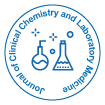

Iveta Bystroňová, Pavlína Kušnierová*, Pavel Walder, Rudolf Hlubek, David Stejskal
Joint infections with non-specific presentation are still difficult to diagnose. We sought to identify biochemical markers in Snovial Fluid (SF) that can predict susceptibility to ongoing inflammatory processes in the joint cavity. Ninety-two consecutive patients were divided into four SF groups based on clustering analysis: non-inflammatory SF (73%), inflammatory-non-pyogenic (12%), inflammatory-pyogenic (10%), or hemorrhagic (5%). We measured and compared the levels of the following biochemical markers in SF: glucose, lactate, total protein, uric acid, C-Reactive Protein (CRP), Leukocyte Count (WBC), Mononuclear (MNP), Polymorphonuclear (PMN), Interleukin (IL)-1 beta, IL6, Procalcitonin, Presepsin, Neutrophil Gelatinase-Associated Lipocalin (NGAL), Human Neutrophil Defensin 1-3 (HNP1-3), Cartilage Oligomeric Matrix Protein, Lactoferrin (HLF2), Polymorphonuclear Elastase (PMNE), Matrix Metalloproteinase (MMP)-1, and MMP-3. Discriminant analysis predicted the classification of individual SF samples into the relevant SF groups with an accuracy of 94.4%. We found a significant difference between WBC, PMN, MNP, CRP, IL-1β, IL-6, HNP1-3, HLF2, PMNE, and individual groups of SF type (p0.6; p0.6; p<0.0001), and between PMN and MNP in the inflammatory-non-pyogenic and inflammatory-pyogenic SF groups (rs= -1.000; p<0.0001). PMN, MNP, WBC, CRP, and HNP1-3 in SF predicted the inflammatory processes with excellent diagnostic performance. The combination of these SF biomarkers can contribute to earlier diagnosis of the inflammatory process in the joint cavity.